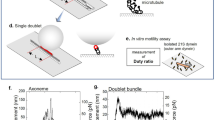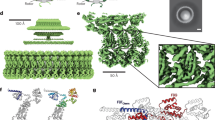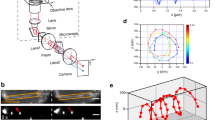Abstract
There is now considerable evidence that the basis for ciliary and flagellar movement is an active sliding between peripheral doublet microtubules which, when resisted by structures within the axoneme, leads to axonemal bend formation1–4. In contrast, relatively little is known about the control mechanisms which coordinate the interdoublet sliding and axonemal bending to produce the effective motion observed in various cilia and flagella5. One component of the axoneme which may be involved in this control is the central pair of microtubules6,7. To learn more about the action of the central pair, we have studied the tiny uniflagellate marine alga, Micromonas pusilla. The central tubules of the M. pusilla flagellum extend for several micrometres beyond the termination of the peripheral doublets8, thus permitting direct observation of the central pair during flagellar movement. Our findings, reported here, indicate that in living M. pusilla the central pair of microtubules undergoes continuous rotation in one direction. This rotation provides the motive force for the cell.
This is a preview of subscription content, access via your institution
Access options
Subscribe to this journal
Receive 51 print issues and online access
$199.00 per year
only $3.90 per issue
Buy this article
- Purchase on Springer Link
- Instant access to full article PDF
Prices may be subject to local taxes which are calculated during checkout
Similar content being viewed by others
References
Satir, P. J. Cell Biol. 39, 77–94 (1968).
Summers, K. E. & Gibbons, I. R. Proc. natn. Acad. Sci. U.S.A. 68, 3092–3096 (1971).
Gibbons, B. H. & Gibbons, I. R. Biochem biophys. Res. Commun. 73, 1–6 (1976).
Shingyogi, C., Murakami, A. & Takahashi, K. Nature 265, 269–270 (1977).
Brokaw, C. J. & Gibbons, I. R. in Swimming and Flying in Nature (eds Wu, T. Y.-T. et al.) 89–126 (Plenum, New York, 1975).
Bessen, M. et al. J. Cell Biol. 86, 446–455 (1980).
Omoto, C. K. & Kung, C. Nature 279, 532–534 (1979).
Manton, I. J. mar. Biol. Ass. U.K. 38, 319–333 (1959).
Manton, I. & Parke, M. J. mar. Biol. Ass. U.K. 39, 275–298 (1960).
Ringo, D. L. J. Cell Biol. 35, 543–571 (1967).
Dute, R. & Kung, C. J. Cell Biol. 78, 451–464 (1978).
Omoto, C. K. & Kung, C. J. Cell Biol. 87, 33–46 (1980).
Tamm, S. L. & Tamm, S. J. Cell Sci. 20, 619–639 (1976).
Tamm, S. L. & Horridge, G. A. Proc. R. Soc. B 175, 219–233 (1970).
Jarosch, R. & Fuchs, B. Protoplasma 85, 285–290 (1975).
Witman, G. B. et al. J. Cell Biol. 76, 729–747 (1978).
Afzelius, B. A. J. Biophys. Biochem. Cytol. 9, 383–394 (1961).
Gibbons, I. R. J. Biophys. Biochem. Cytol. 11, 179–205 (1961).
Gibbons, I. R. in Molecules & Cell Movement (eds Inoué, S. & Stephens, R. E.) 207–232 (Raven, New York, 1975).
Starr, R. C. J. Phycol. 14, Suppl., 47–100 (1978).
Spurr, A. R. J. ultrastruct. Res. 26, 31–43 (1969).
Reynolds, E. S. J. Cell Biol. 17, 208–212 (1963).
Author information
Authors and Affiliations
Rights and permissions
About this article
Cite this article
Omoto, C., Witman, G. Functionally significant central-pair rotation in a primitive eukaryotic flagellum. Nature 290, 708–710 (1981). https://doi.org/10.1038/290708a0
Received:
Accepted:
Issue Date:
DOI: https://doi.org/10.1038/290708a0
This article is cited by
-
A natural toroidal microswimmer with a rotary eukaryotic flagellum
Nature Microbiology (2019)
-
The basal bodies of Chlamydomonas reinhardtii
Cilia (2016)
-
Ultrastructural and biochemical analysis of a new mutation in Chlamydomonas reinhardtii affecting the central pair apparatus
Protoplasma (2007)
-
Bases moléculaires du mouvement flagellaire
Andrologie (1995)
Comments
By submitting a comment you agree to abide by our Terms and Community Guidelines. If you find something abusive or that does not comply with our terms or guidelines please flag it as inappropriate.



